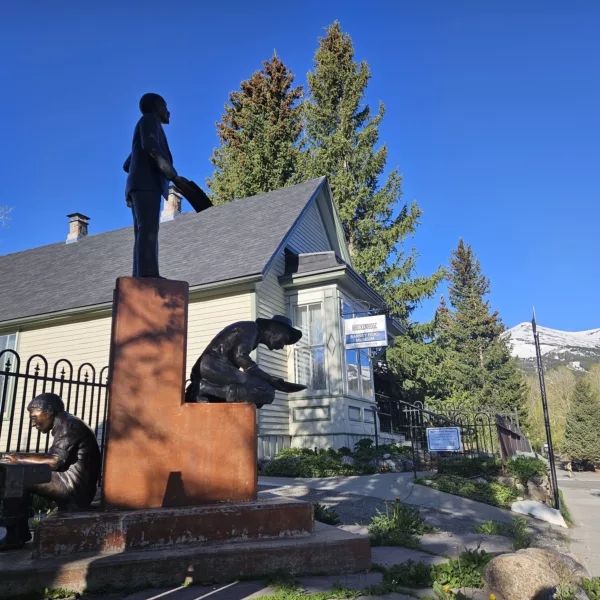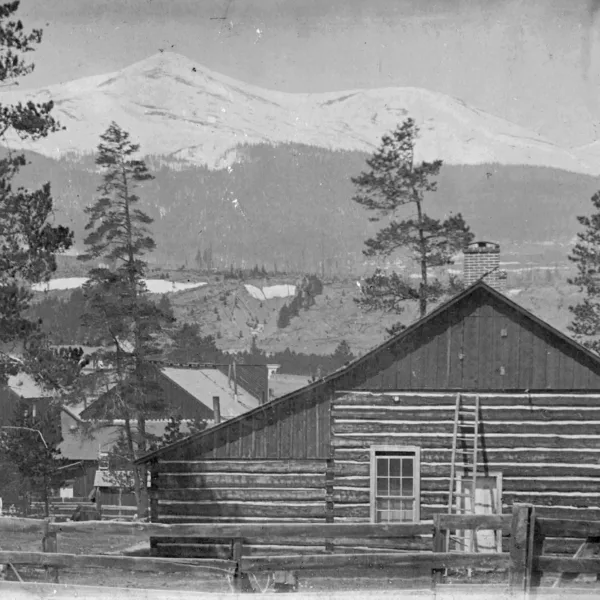Florence Watson’s Way: A poet in Breckenridge
March 07, 2023 | Category: Our Collective History
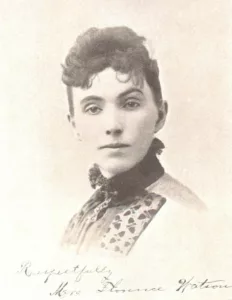
TABLE OF CONTENTS
EARLY LIFE
BUILDING A LIFE IN BRECKENRIDGE
A POET AT HEART
FROM POEMS TO PROSE
WRITING THROUGH HARDSHIP
GENERATIONALLY HEADSTRONG
SOCIAL CAPITAL
SOURCING THE STORY
ADDITIONAL BLOGS
In honor of International Women’s Day, we are examining the life of one of Breckenridge’s best known poets, Florence Watson. Life for women in the 1800s wasn’t easy, nor was it easy living in the mountains of Colorado. However, Florence Watson managed to flourish in Breckenridge at that time.
EARLY LIFE
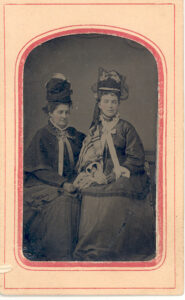
Florence Norris Watson as a teen with her sister. Photo credit: Wendy Wolfe Research Collection
Florence L. Norris was born in Crawford County, Pennsylvania, in 1850. At the time, records on women were sparse. Not much is known about Florence’s early life until she was married. In 1876, Florence married George B. Watson in Iowa. George was a businessman and mine investor, and the two remained in Iowa for about a decade. During that time, the family saw plenty of hardships with the loss of two young children. After the second child, Don, died in December 1885, the couple soon moved to Breckenridge to begin a new life.
In Breckenridge, George opened his own store, George B. Watson’s Clothing and Gents Furnishings. He also continued to invest in mining operations in the area and was an avid outdoorsman. Many Summit County Journal articles highlight George’s hunting and fishing exploits. Some trips were less than successful, as illustrated by one article titled “The Nimrods’ Return.” The article pokes fun at George’s “empty game sacks” upon returning from big-game hunting in October 1907.
But George wasn’t the only one carving out a career and active social life. During this time, Florence truly began to flourish with the publication of her own book of poetry. She also gave birth to two children and took the social world by storm.
BUILDING A LIFE IN BRECKENRIDGE
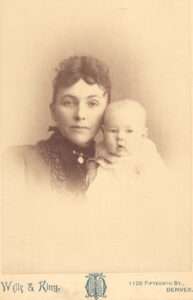
Florence Watson and Collie, April 17, 1888. Photo credit: Wendy Wolfe Research Collection
After arriving in Breckenridge, Florence gave birth to another son, Collingwood Watson in 1887. Collingwood was the first of the Watson children to survive past infancy and he spent his life in Breckenridge. Not much is known about Collingwood’s early life, but he became a railroad conductor and mine owner.
On March 31, 1891, when Florence was 41 years old, she gave birth to a daughter, Florence E. Watson. Thanks to the society pages of local newspapers, we know Florence raised her namesake to be a social powerhouse. We can glean from articles, Florence and George ran a tight ship and the expectations were high for the younger Florence. For the majority of her time in school, Florence made the honor roll and was listed as having never been absent or tardy. She recited poems at school events, performed solos on a variety of instruments during musicals and was even made to perform at a celebration for George Washington’s Birthday that her mother had organized in 1901. The Summit County Journal covered Washington’s party saying, “The function, like all those at the Watson residence, was a social attainment.”
Young Florence was clearly a star pupil while attending school in Breckenridge through 1905 before being sent to Wolfe Hall in Denver to continue her high school education in September 1906. But don’t feel too bad for young Florence; it seems her parents ensured she had a very nice life in Breckenridge. An article in the Summit County Journal from 1908 describes the young girl as “the only daughter of Mr. and Mrs. G.B. Watson, and a child upon whom every luxury had been showered and whose every wish was law.”
While raising their family in Breckenridge, Florence and George became prominent citizens of the town, and their house on Ridge Street became one of the centers of the social scene. Soirees, teas, and even children’s birthday parties made the newspaper and Florence used her position in the community to be able to tell her own story in her own words.
A POET AT HEART
Like many Breckenridge residents, Florence was inspired by the world around her. She poured that inspiration into her poetry, culminating with her own book of poems, “Sweet Summer Land”, published in 1893. The book was featured at the World’s Columbian Exposition, or world fair, in Chicago that same year. Florence’s book stood proudly alongside such modern marvels as the Ferris wheel in the sprawling fairgrounds which covered more than 600 acres. The fair ran for six months, with September 12, 1893, designated as Colorado Day.
As a reflection of Colorado, Florence’s book literally encapsulated Breckenridge in the late 1800s. It was buried as part of a time capsule when the Summit County Courthouse was constructed in 1909. The cornerstone laying was a huge ceremony in Breckenridge and items added to the time capsule were recorded in the August 7, 1909, Summit County Journal. Items included:
- The resolution creating the new courthouse
- Local newspapers
- Coins
- Samples of local bond issues
- Gold nuggets
- “Sweet Summer Land” by Florence Watson
“Sweet Summer Land” featured poems gushing about the beauty of Breckenridge summers. Her poems also gloss over the hardships of the winters.
FROM POEMS TO PROSE
Florence’s ability to tell a story didn’t end with the publication of her poems. Throughout her life, Florence wrote a number of pieces for the local newspapers and even contributed articles during some of the most difficult times in her life. She wrote about goings-on around town, but also about her own life and the issues that mattered most to her.
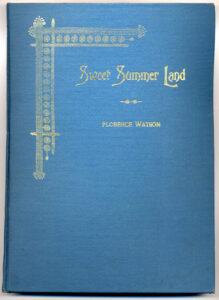
Book cover for “Sweet Summer Land” Photo credit: Wendy Wolfe
In one of the first examples of Florence’s determination to talk about important issues, she wrote an editorial on women’s suffrage for the October 14, 1893, Summit County Journal. Keep in mind, while she was writing this editorial, Florence was also raising an 8-year-old boy and 2-year-old daughter, while navigating life high in the Rocky Mountains:
“Woman is not inferior to man intellectually. All she wants is a chance … Oh! I tell you it is time woman should have a voice in the framing of laws that she has to obey and the time is surely coming when woman will take her true position on an equality with man by the right of the ballot.”
Furthermore, she signed the article “Mrs. Florence Watson” instead of Mrs. George Watson, which was how women were commonly referenced at the time. From that point on, in many articles with Florence as either the subject or writer, her name continues to appear as “Mrs. Florence Watson” and it is only when George is also mentioned that her first name is neglected.
A true mountain woman, Florence faced more than her fair share of hardships in life, but managed to stand strong and work as a voice for others even in the face of unimaginable sorrow.
As mentioned earlier in this blog, two of Florence’s children did not survive past infancy, and yet when a close family friend’s daughter died at 2 years old, Florence is the one who authored the obituary. In the obituary for Clara Keller, Florence penned a poem “The choicest flowers bloom to fade– / the dearest forms in earth are laid– / God called her spirit home to dwell, / because ‘He doeth all things well’,– / We know although for now we weep, / He giveth His beloved sleep.”
Before describing the services held at the Keller home, where her own daughter was a pall bearer alongside three other little girls, Florence concludes her poem: “All of love and life and gladness / Ripens on that unseen shore, / Sweetest, fairest, fadeless flowers, / Bloom in beauty evermore. / Think not of the tearful parting. / For beyond deaths turbid tide / You will some day meet your darling, / Heaven is on the other side.”
WRITING THROUGH HARDSHIP
When her own daughter fell ill in 1908, Florence again took up her pen as she dealt with the hardship. Articles in the Summit County Journal show young Florence suffered from pneumonia for six months. Eventually, Florence had to take her daughter to St. Anthony’s Hospital in Denver, writing, “Six weeks today since I left Breckenridge on the sad mission of bringing Florence to this hospital, it being, as you know, a case of ‘life or death’ with her. The six weeks spent here has only strengthened our former opinion in regard to this place – that it is the best on earth for the sick and dangerously ill.”
Florence goes on to describe in detail the 40 Sisters of St. Francis who ran the hospital: “Sister M. Xavier has charge of the second floor, where we are, and a more faithful, beautiful character would be hard to find.” She then spends the majority of the article focusing on their efforts and remarking on the cleanliness of the hospital.
Near the end of the article, Florence explains the true depth of their visit to the hospital. She praises Dr. Hawkins, who performed a “skilful (sic) and successful operation” on an abscess on young Florence’s lung. Florence then quickly changes subjects to tell her friends in Breckenridge how lovely the weather was in Denver. She planned to return to Breckenridge within the month, but young Florence had other plans in mind.
GENERATIONALLY HEADSTRONG

Portrait of a graduating high school class in Breckenridge, Colorado. Florence Watson is number 12. Photo credit: Denver Public Library
While Mrs. Florence Watson did return to Breckenridge following her 17-year-old daughter’s illness, Miss Florence Watson stayed in Denver and became Mrs. Florence Waltz. Unbeknownst to the Watsons or the Waltzes – both prominent families in Breckenridge – their young children decided to elope.
The groom, Fred Waltz, was brother to Martin Waltz, a railroad agent, and Dr. J.F. Waltz, Summit County physician. He was supposed to be attending school in Michigan at the time of his wedding in Denver.
Florence and George Watson meanwhile had dreams of their daughter also attending college after recovering from her illness, but as a Fourth of July article in the 1908 Summit County Journal says, “But—if and! As it is, the plans of both the Watson and Waltz families have been irreparably disturbed and there is nothing else to do but to acquiesce in the whims of Cupid and permit the couple to enter up the responsibilities of married life in their own sweet way, unhampered by word or act from any source.”
The Breckenridge Bulletin also wrote an article about the couple’s nuptials. It explained that both papers found out from the Denver Times at nearly the same time the parents did.
The Journal article goes on to explain the Watsons “were just preparing for their daughter’s return home, set for next week, when news of the marriage came. Many pleasant events for the summer had been planned, and to have those anticipated pleasures thus suddenly and ruthlessly shocked caused much grief to her parents.” No author is listed for the Summit County Journal article.
SOCIAL CAPITAL
In the late 1800s, navigating and managing the social scene was a key role for women. Florence mastered the social scene to the point that her daughter’s ninth birthday was fit for print. It should be noted that the article was authored by “F.W.”, which might mean Florence decided to praise her own party. If so, she paints an impressive picture: “The G.B. Watson home was thrown open to forty-five little girls. Welcome was written everywhere, the glorious sun shedding his light and warmth throughout the rooms, and lovingly caressing the stars and stripes, bringing into prominence our beautiful independence, which filled all present with the spirit of jollity, noise and general hurrah which marks the day of the patriot in honor of the flag we love so much.”
The author of the article also notes how young Florence behaved as a hostess well past her years, and the article, of course, concludes with a poem: “Then grow, my sweet Florence, as well as you / may, / And be like somebody true; / For high-born dames of noblest heart / Have been as tiny as you. / And in the woman of twenty-nine / May we find the maiden of nine.”
Beyond her daughter’s birthday, Florence seemed to attend every major social party that took place anywhere near Breckenridge. Stories in local newspapers mention picnics in Dillon and even weekends spent at Judge Clark’s house in Denver. But nothing compared to when the Watsons would open up their own home for social gatherings. When she invited 30 prominent women for a party, the newspaper read, “As a clever hostess Mrs. Watson has few equals, and on this occasion her guests were entertained with more than usual grace.”
Florence Watson continued to be a social giant in Breckenridge throughout her life before passing away at about 77 years old.
Visit the Breckenridge Welcome Center Theater to view “Sweet Summerland”, an abbreviated documentary about Florence Watson’s life.
SOURCING THE STORY
This story is researched from Colorado Historic Newspaper Collection, Library of Congress collections, Breckenridge History videos, and with co-workers’ help. Through these methods, we were able to create a timeline for Florence Watson’s life, but as you can see, there are some areas of the story that are missing. That is one of the difficulties when researching women and others who were, historically, not written about as much. We are lucky to have so many details from Florence’s life and that is largely because she made it so. Without her commitment to writing her own story or even the simple fact that she used her own name, much of her story would probably also be lost to time.
ADDITIONAL BLOGS
If you are interested in learning about more prominent women in Breckenridge, check out these blogs:
Women of Willpower: Breckenridge Pioneers
Written by Susan Gilmore


